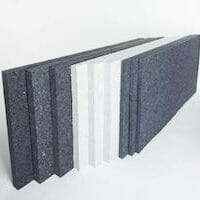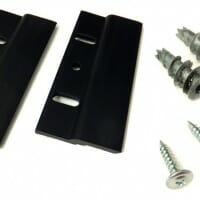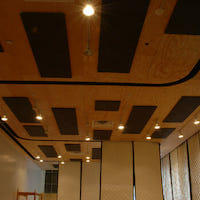How many Acoustic Panels do I need?
Constant unwanted noise can cause irritation for even the calmest of people. And when it comes to the office, noise distractions can seriously impact work performance and employees’ moods.
A recent study found that 69% of employees across the world experience a decrease in focus and work efficiency due to noise in the workplace.1 Noise impacts the body mentally and even physically, making it harder to recall information and increasing stress levels.1
Whether you’re facing noise pollution in the office or unwanted echoes in a large auditorium, a great solution is installing acoustic panels to absorb and control sound.
This leads to the next question: how many acoustic panels do I need?
Continue reading for an in-depth look at acoustically treating a space with acoustic panels.
The Basics of Acoustic Panels
The number of acoustic panels a space requires can’t be calculated with a single equation. That’s because there are many factors that impact the amount you’ll need to adequately absorb sound.
To understand why, let’s break down what acoustic panels are and how they work.
What Are Acoustic Panels?
Acoustic panels are panels made of soft, sound-absorbent materials that are installed on walls and ceilings to limit the amount of sound traveling around a space.
When looking into acoustic panels, you may have asked yourself the question: how much soundproofing do I need? But acoustic panels aren’t actually used to soundproof a space, although they may be used in conjunction with a soundproofing material.
Professional soundproofing prevents sound waves from entering or leaving a space. Acoustic panels, on the other hand, are used for noise control, including sound absorption and diffusion.
Different Types of Acoustic Panels
There are several different types of acoustic panels, the main ones being absorbers, diffusers, and bass traps. Each has a slightly different look and function:
- Absorbers – Sound absorption panels soak up the sound waves to prevent them from reflecting and creating echo
- Diffusers – Create more sound reflection angles to scatter soundwaves throughout a room, diminishing unwanted noise
- Bass traps – Typically placed in corners where bass sounds collect, they trap low-frequency noises for better sound quality in a room
When looking at panels to install, take note of its Noise Reduction Coefficient (NRC) rating. The NRC rating is a decimal number between 0 and 1, and it indicates how sound-absorbent a type of panel is.
Each product offered by Acoustical Surfaces is equipped with an NRC rating to make sure you’re getting exactly what you need.
Materials Used in Acoustic Panels
The materials that acoustic wall panels and ceiling panels are made of will have a significant impact on their effectiveness. The most common materials used are:
- Foam
- Fabric-covered fiberglass
- Vinyl
- Fibers like cotton or wool
These materials are known for their thickness and porousness, allowing sound waves to be caught inside rather than bouncing off their surfaces.
Acoustical Surfaces offers acoustic panels made of speciality materials such as CFAB cellulose, made of 65–75% recycled content and environmentally friendly, and Rigid Porous ARPRO Acoustical (P.E.P.P.), a class A fire rated, non-fibrous option.
The Science Behind Acoustic Panels
You don’t need to be an expert in sound waves and soundproofing to understand the inner workings of acoustic panels—you have us for that. Let’s take a quick look at the way sound travels and how acoustic panels are designed to absorb it.
How Do Acoustic Panels Work?
Sound travels as a wave. When something disturbs the air—for example, your hands clapping together—the disturbed air vibrates rapidly as it travels away from your hands. These sound waves can then reflect off of other objects like walls or ceilings and travel back toward you, creating what we call an echo.2
While it can be entertaining to test the echo and reverberation in an empty warehouse or a canyon, echoes can be a distraction and a nuisance in your home or office.
Acoustic panels are designed to absorb the sound wave so they don’t continue to bounce around a room after they’re created. They are softer and thicker than walls and ceilings, which prevents sound waves from reflecting as easily.
The Importance of Panel Thickness and Density
The thickness and density of an acoustic panel is another determinant of its effectiveness.
Sound waves reflect most easily off hard surfaces, and can travel through thin barriers like walls and doors. Adding more thickness and density to the walls of your space via acoustic panels will ensure that less sound makes its way through.
A product’s density is measured by the pound. The heavier it is per volume, the denser it is.
Integrating Acoustic Panels into Architectural Design
Now that you have a better understanding of the functions and advantages of acoustic panels, let’s take a look at how to incorporate them into your space.
Acoustic Panel Placement Strategies
Every space is unique: the dimensions, the building materials, and its intended purpose will all influence how you place your acoustic panels.
Assess the room you want to acoustically treat: Are there lots of corners, high ceilings, or even curved walls?
Acoustic panels are versatile and can be installed on pretty much any surface, including walls, ceilings, and doors. They can be placed directly on surfaces or be suspended from the ceiling as baffles or clouds.
Acoustic panels or soundproofing panels are most commonly placed on first sound reflection points, which are the areas in a room that a sound wave first encounters, creating the strongest echoes. Covering these first reflection points with acoustic sound panels is key to controlling sound quality.
Aesthetic Considerations for Acoustic Panels
Because acoustic sound panels are installed on walls and ceilings, their ability to control airborne noise isn’t the only thing that matters. Their look must also be taken into account.
Do you want your acoustic panels or soundproofing panels to blend into the background, or do you want to incorporate them more prominently into your interior design plans?
No matter what your stylistic vision is, Acoustical Surfaces has acoustic panels designed with both function and style in mind. Our acoustic panels come in many different colors and finishes to perfectly match your space’s theme.
Specialized Panels for Unique Architectural Needs
Sometimes, a space is so unique that most standardized acoustic panels won’t fit nicely anywhere. If that’s the case, you may need to look into specialized panels.
Acoustical Surfaces specializes in custom-made acoustic panels that are made on a per-job basis so they fit your space perfectly.
Determining the Right Amount and Type of Panels
Now that you have a solid understanding of acoustic panels and their uses, let’s discuss how to determine the right amount for your space.
We’ve developed a general formula you can use to get a basic idea of how many panels you’ll need:
- Cubic Volume of the room x 3% = square footage of product
- Height x Width x Depth x 0.03 = Sq/Ft
This formula calculates the absolute minimum amount of paneling to install. As noted above, however, one formula doesn’t speak to the entire job. You may find that you need more based on other factors.
Key Factors to Consider
While the formula above can be helpful initially, there are other important factors that will affect the amount and type of panels you need. Some things to keep in mind include:
- Room size – Echoes are amplified in large spaces because the sound waves have more room to travel and bounce.
- Room purpose – What level of noise control are you looking to achieve? A banquet hall will require more paneling than a small recording studio or office. That said, adding too many acoustic panels to a room can actually have a negative effect, making the room sound “dead.”
- Existing acoustics – Believe it or not, your space may actually have natural acoustics you can work with. Carpeted floors can act as absorbers, while furniture can act as diffusers. The more existing acoustics in your space will decrease the amount of panels you need.
Before you start installing, make sure you have a strong understanding of what your space truly needs.
Common Mistakes and How to Avoid Them
As mentioned above, you can run the risk of installing too many acoustic panels. You may assume that more is better, but this can lead to undesired sound quality and a deadened atmosphere. Conversely, installing too few panels will lead to ineffective noise control.
By learning as much as you can about acoustic panels and following the advice in this article, you’ll be able to avoid making mistakes with your acoustic treatment project.
Acoustical Surfaces Has Acoustic Panels For Every Space
Whether you’re soundproofing an office, a recording studio, or a large auditorium, Acoustical Surfaces has the acoustic panels you need for an echo-free space.
We offer a large variety of products, from absorbers, to diffusers, to bass buster traps, ranging in material and sound-absorption levels to suit your specific needs. Aesthetics won’t be an issue either: our products come in multiple finishes that can blend with the style of any room.
If you have more questions about soundproofing and acoustical treatments contact Acoustical Surfaces today.
Sources:
- Metrikus. Reducing Noise Pollution in the Office. https://www.metrikus.io/blog/noise-pollution-is-killing-your-productivity-what-can-you-do-about-it
- Explain That Stuff. Sound. https://www.explainthatstuff.com/sound.html
- FeedSpot. 45 Best Soundproofing Blogs and Websites. https://interior.feedspot.com/soundproofing_blogs/








2 Comments
Mitch
Thanks for the rule of thumb! I have a critical listening room that is 30’L x 15’W and 8’H. The stereo speakers are along the long wall. The room is comprised of hardwood floor, windows, and bare drywall, inlcuding the ceiling.
I am interested in your dBA panels as it looks like I can just glue them on the drywall. Using the calculation, it appears I need 108 sq ft of product. Is that right? Also, how do I choose between the 1″ or 2″ thickness?
Finally, where should they be placed? I presume the ceiling and back wall where the stereo is pointing? How far apart do I install the panels from each other in order to be effective?
Many thanks!
Ted W
Thanks for the Comment, Mitch.
We may want to talk a little bit about a critical listening room as the “rule of thumb” is really a better formula to “take the edge off” of a room and simply reduce the overall reverberation time. A critical listening room is likely going to need a more room-specific approach.
Would you be able or willing to send me a sketch of the room showing the general location of everything and maybe a digital photo or two so that I could have a look at it and help lay out a plan of attack for you?
The dBA panels may or may not be the best for you, that is going to depend on the room itself. Most of our products can be glued or mounted directly to the wall. The “best” approach may be to use a few different products in specific locations.
If you are able to send me a bit more information about the room, please use [email protected] and include your contact information.
Thank you!!!
Ted